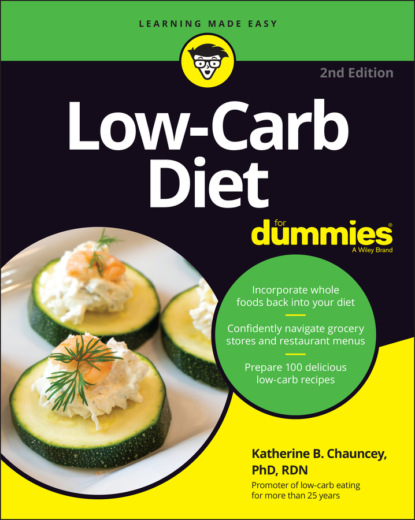a free food and ate the whole box rather than just a serving.
Scientists realized a change needed to happen to provide guidance to consumers to help them eat healthier. That’s how the Healthy Eating Plate came about. Designed by experts at Harvard School of Public Health and Harvard Medical School, the Healthy Eating Plate (see Figure 3-1) directs consumers to the healthiest choices in major food groups.
Copyright © 2011 Harvard University.
FIGURE 3-1: The Healthy Eating Plate.
www.thenutritionsource.org and health.harvard.edu.
A number of research studies suggest that diets designed to lower the insulin response to ingested carbohydrate (such as a low-glycemic-index diet) may improve utilization of stored energy (body fat), decrease hunger, and promote weight loss. The Healthy Eating Plate demonstrates that such a diet would have as its base abundant quantities of low- to moderate-glycemic vegetables and fruits, moderate amounts of protein, legumes, reduced-fat dairy, and healthy fats (like olive and canola oil), and an emphasis of whole grains over refined-grain products, potatoes, french fries, and concentrated sugars. The Whole Foods Weight Loss Eating Plan closely approximates the recommendations of Harvard’s Healthy Eating Plate (refer to Chapter 2 for more about this plan).
Going Low-Carb without Going Extreme
Following any diet that doesn’t allow you to get the minimum requirements of key nutritional benchmarks, including fiber, calcium, fat, protein, and carbohydrate can have disastrous long-term health complications. Always seek input from your healthcare provider before altering your diet or beginning an exercise program.
Constipation: Severe carbohydrate restriction eliminates fruit, vegetables, and grains. The resulting low fiber intake can lead to constipation and gastrointestinal problems.
Dehydration and low blood pressure: This results from the excessive water loss in the early stages of the diet.
Dizziness and fainting: This can result from low blood pressure due to the dehydration. It’s often felt when standing up too quickly.
Nausea and fatigue: Both are often associated with ketosis (burning fat for fuel) and low blood-sugar levels.
Halitosis: Halitosis is bad breath. It’s also associated with an excess amount of ketones (a byproduct of burning fat for fuel) in your body. This occurs when someone is in ketosis. It has been described as smelling like a cross between nail polish and overripe pineapple. (Just the kind of thing you’re striving for, right?)
Ketosis: Ketosis is a condition resulting from switching from using carbs to fat as the primary energy source. As your body metabolizes fat, it gives off ketones; excess ketones show up in your urine. Although ketosis is your body’s natural backup survival system, when it occurs over an extended period of time, it can cause light-headedness and fogginess. In some medical conditions, prolonged ketosis can cause coma and even death. Being in ketosis continually isn’t normal or healthy, and the long-term safety of this condition is unknown. Ketosis definitely isn’t good for children.
Short-term weight loss: Initial weight loss is due to water loss and levels off in about 7 to 14 weeks. Permanent weight loss occurs more slowly and only if you stay on the diet. When you stop following a low-carb diet and you return to normal eating, the weight usually returns.
Loss of muscle mass: Your body needs a source of glucose. In diets with too low a restriction in carbohydrate (below 130 grams), your body starts to metabolize the protein in muscle tissue in order to get carbohydrate. This eventually weakens your body.
Increased workload on your kidneys: Very low-carbohydrate diets are associated with excess protein and fat intake. High protein intake puts an added burden on the kidneys and liver. If you have diabetes, you already have an increased risk of kidney disease, so be sure to check with your healthcare provider before following a high-protein diet. If you already have kidney disease, then a very low-carb diet definitely isn’t for you.
Kidney stones and gout: A high protein, ketosis-inducing diet, can lead to high uric acid levels in the blood, increasing the risk of kidney stones and gout.
Increased risk of heart disease: Diets very low in carbohydrate are usually high in saturated fat and high in animal protein. High saturated fat increases the risk of heart disease and some forms of cancer.
Increased risk of some cancers: The risk of many cancers is likely to be increased when most fruits, vegetables, whole grains, and beans are eliminated from the diet.
Osteoporosis: High animal protein intake combined with the ketosis from a very low carbohydrate intake is thought to draw calcium from the bones, leading to calcium depletion and increasing the risk of osteoporosis and hip fractures. Also, rapid weight loss can accelerate bone deterioration and cause osteoporosis.
Vitamin and mineral deficiencies: When entire food groups are eliminated from a diet, such as fruits, vegetables, grains, and dairy, vitamin and mineral deficiencies can occur. High-protein, very low-carbohydrate diets usually lack several vitamins and minerals such as vitamins A, C, D, the B vitamins, antioxidants that can slow the effects of aging, and calcium.
Chapter 4
Determining Whether Low-Carb Eating Is Right for You
IN THIS CHAPTER
Not every diet is beneficial to every person. Some people are in perfect health and likely also have nearly perfect diets. Others may need very strict limits or restrictions on foods due to allergies or other conditions. Still others with existing health conditions may need to cut out refined sugars but can enjoy artificially or naturally sweetened foods.
So
